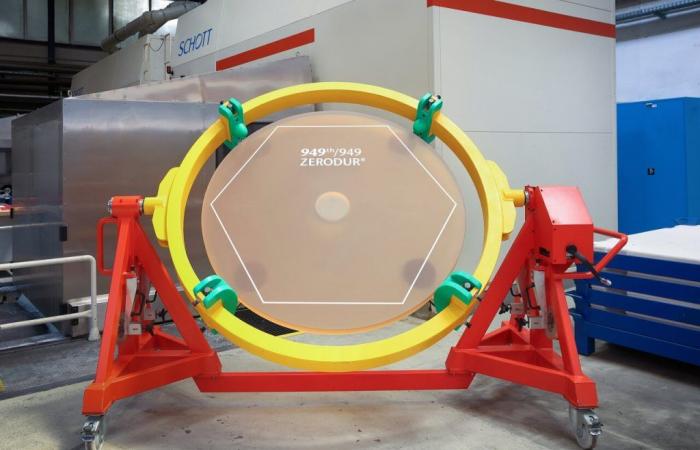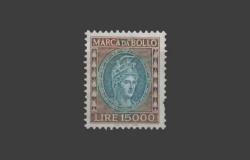The 949th and final segment of the ELT’s primary mirror has also been cast and is ready to be modeled. Credits: Schott
The ELT (Extremely Large Telescope) of the European Southern Observatory (ESO), under construction in the Chilean Atacama Desert, has taken another step towards completion. The German company Schott has successfully finished the last of 949 segments commissioned for the telescope’s primary mirror (M1). With a diameter of over 39 meters, M1 will be by far the largest mirror ever made for a telescope.
Too large to be made from a single piece of glass, M1 will be made up of 798 hexagonal segments, each about five centimetres thick and 1.5 metres wide, which will work together to gather tens of millions of times more light than the human eye. An additional 133 segments have been produced to facilitate maintenance and segment coating once the telescope is operational. ESO has also procured 18 spare segments, bringing the total to 949.
The M1 blanks, shaped pieces of material that are then polished to become the mirror segments, are made of Zerodur, a low-expansion glass-ceramic material developed by Schott and optimized for the extreme temperature variations at the ELT site in the Atacama Desert. The company also produced the blanks for three other ELT mirrors – the M2, M3, and M4 – at its facilities in Mainz, Germany.
“What ESO ordered from Schott is much more than just Zerodur,” he says Marc CayrelHead of ESO’s ELT Optomechanics. “In close collaboration with ESO, Schott fine-tuned every single stage of production, customising the product to meet and often exceed ELT’s very demanding requirements. The exceptional quality of the blanks was maintained throughout the series production of more than 230 tonnes of this high-performance material. ESO is therefore very grateful for the professionalism of the skilled teams at Schott, our trusted partner.”
“Our entire team is thrilled to conclude what has been the largest single Zerodur order in our company’s history,” he says Thomas Werner, project lead Elt at Schott. «For this project, we successfully completed the mass production of hundreds of Zerodur mirror substrates, when we usually operate on a single piece. It was an honor for all of us to play a role in shaping the future of astronomy.”
Once cast, each segment undergoes a multi-stage international journey. After a slow cooling and heat treatment sequence, the surface of each blank is shaped by ultra-precise grinding at Schott. The blanks are then transported to the French company Safran Reosc, where each is cut into a hexagonal shape and polished to a precision of 10 nanometers across the entire optical surface, meaning the mirror’s surface irregularities will be less than one-thousandth of a human hair. Also involved in the work on the M1 segment assemblies are: the Dutch company VDL ETG Projects BV, which produces the segment supports; the Franco-German consortium Fames, which has developed and is finalizing production of 4,500 nanometer-precise sensors that monitor the relative position of each segment; and the German company Physik Instrumente, which has designed and is producing the 2,500 actuators that can position the segment with nanometer precision; and the Danish company Dsv, responsible for transporting the segments to Chile.
Once polished and assembled, each M1 segment is shipped across the ocean to reach the ELT’s technical facility at ESO’s Paranal Observatory in the Atacama Desert: a 10,000 kilometer journey that more than 70 M1 segments have already completed . At Paranal, a few kilometers from the ELT construction site, each segment is coated with a layer of silver to become reflective, after which it will be carefully stored until the main structure of the telescope is ready to receive them.
When it comes into operation later this decade, ESO’s ELT will be the world’s largest eye on the sky. It will face the greatest astronomical challenges of our time and make unimaginable discoveries.
Source: Eso press release
Watch the video of MediaInaf Tv on the Italian contribution to Elt:






